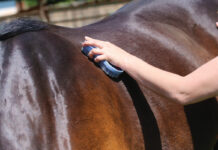
A thick, shiny mane and tail looks glorious on a horse, but it can be elusive to achieve if you’re not careful about properly maintaining the hair.

The trick to developing and maintaining beautiful manes and tails, according to Warmels, is doing as little as possible with them on a daily basis. “We do a visual inspection and run our fingers through the manes and tails,” says Warmels of his daily grooming routine. “At least twice a week, the horses will have a full shampoo bath, and once a week a mane and tail wash.”
Warmels washes the mane and tail separately from the body because the process can take about an hour, and rushing can lead to damaged hair. Warmels removes any burrs and all tangles by hand, gently picking through the hair with his fingers before washing.


Determining which products work best in our horse’s hair will take trial and error. Warmels often uses a conditioner rich in vitamin E to keep the skin and hair nourished. He also says a good detangler is crucial and can facilitate the grooming process.
Warmels applies shampoo and lets it sit for three to five minutes before thoroughly rinsing it out; any suds left behind can irritate the skin and cause the horse to rub, damaging the hair. The next step is to condition the mane and rinse it again (sometimes he uses a leave-in conditioner depending on the horse and the state of the hair), and then he blow dries it and picks through it again with his fingers.


Braiding can help manes and tails grow long and thick by preventing tangles and breakage, but this doesn’t work with every horse.
“Some horses do great with braids and others will just destroy them,” says Warmels. “Ideally, you would like to braid the mane and tail, leave them for a day or two, take out all the braids and condition the hair, and then re-braid. This, however, is very time consuming.”



No matter how much time and effort you put into your horse’s long, luxurious mane and tail, there are many hazards that threaten to undermine your hard work. “Buckets are the biggest demise of tails,” says Warmels. To prevent hair loss due to your horse’s tail getting caught on the ends of bucket handles, Warmels suggests wrapping them with electrical tape.
By being dedicated to keeping up with these hair care tips, your horse’s mane and tail will be the envy of your barnmates.






Wow, that is a lot of work for, “doing as little as possible”. I brush my horse’s mane and tail about once a month. Perhaps I should do it more often because in my opinion they’re way too thick. As for washing, why would it be necessary to wash twice a week?
Thanks for the great article.
Dear Galadriel, good comment. The horses in this article are in “full training” meaning that they are worked on a daily basis and shown monthly at breed- and/or sport events. The horses are 24/7 kept in show condition, that why the care seems a bit intense.
Very useful for showing your horse.
Interesting and useful.
Helpful!
I would live to know brands of conditioners and detanglers they like. My horse has long course hair and not all products work the best.
Hosing a horse off (when it’s hot, e.g.) is ok but it is so wrong to shampoo bath a horse twice a week! Their skin dries out and it looses its natural protection.
I was told never to leave a raid in a tail it could get badly snagged and torn off